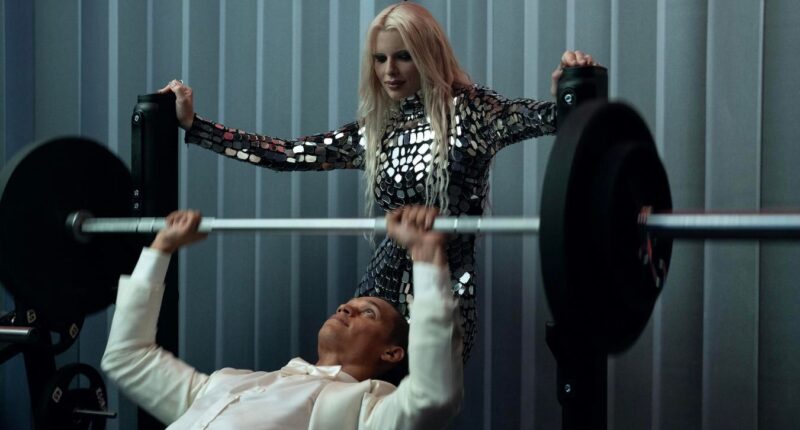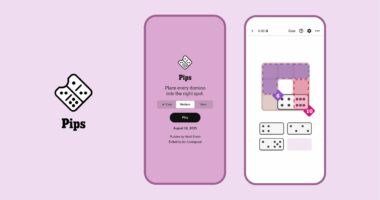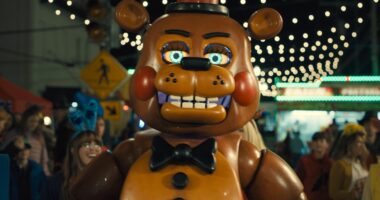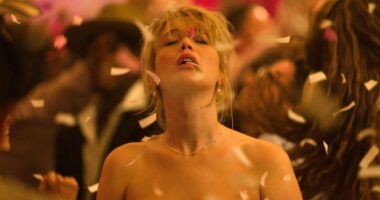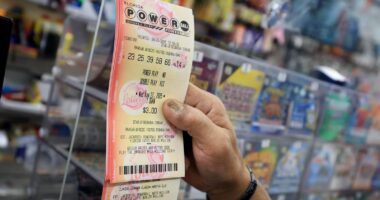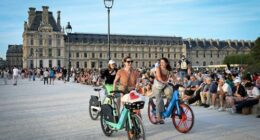Share this @internewscast.com
By now, many have probably caught a glimpse of the film from Monkeypaw Productions titled Him, which debuted on September 19. Under the direction of Justin Tipping and the production of Jordan Peele, this film takes audiences on a thrilling psychological journey set in a dystopian world where football dominates and ambition knows no bounds. Here, the quest to be the greatest overshadows the looming physical and emotional costs.
Right from the start, viewers meet Cameron Cade, an ambitious college quarterback on the brink of stardom. However, his promising journey towards the NFL is derailed when he is assaulted by a masked assailant. This attack results in a potentially career-ending brain injury, leaving him confused yet oddly optimistic, refusing to abandon his dreams. Against medical advice, he turns to Isaiah White, a legendary quarterback portrayed by Marlon Wayans, for training. Upon reaching Isaiah’s secluded desert home, the film takes on a darker, more twisted tone.
What captivated me most about this movie was its stunning visual appeal. Filmed primarily in Albuquerque, New Mexico, the barren landscapes and muted color palette provided a stark contrast to the characters’ vibrant costumes. These costumes were not merely decorative; they played a pivotal role in the narrative.
The attire in the film was carefully curated to reflect not just the story but also the emotional shifts and foreboding sense of danger experienced by the characters. Emmy-nominated costume designer Dominique Dawson explained the intentionality behind these choices. “Creating a unique universe is challenging when the characters’ paths are uncertain. Reading the script, I focus on the tone—how does this universe operate?” she shared via Zoom. “If I had to sum it up, it would be psychosis. We wanted to delve into the athlete’s experience, highlighting the physical toll and untreated injuries, which can silently evolve into mental health issues.”
Throughout the film, the costumes contributed to its surreal, fragmented narrative. Even though the main characters are driven, they struggle to discern reality from illusion. Dawson and her team designed the costumes to amplify this theme of psychosis. The New Mexico setting also played a crucial role in shaping the film’s unsettling atmosphere. “Filming in such a sparse landscape informed us about the characters’ socio-economic conditions, their motivations, desires, and fears. We explored how these elements could be expressed visually,” she explained.
The Art of Costume Design in ‘Him’
Throughout the film, you see the its disjointed surrealism in its costumes, because even though the lead characters are committed and focused on their goals, they aren’t able to distinguish what is real from what isn’t. So, Dawson and her team wanted the costumes to push that envelope and further that story of psychosis. The shoot location also greatly contributed to the film’s dysphoric tone and costumes. “We shot in New Mexico, so it’s this desolate landscape. After understanding the geography of your setting, we delved into the economic aspects: where are these characters? What drives them? What are their innermost desires? What are their fears? And then, how does that materialize?” she states.
Isaiah (Marlon Wayans) in HIM, directed by Justin Tipping.
© Universal Studios. All Rights Reserved.
On The Costume Design Process For ‘Him’
To achieve each costume narrative, Dawson and her team built extensive decks that broke down the aesthetic and the look, including the colors and textures you would expect to see for each character. The details ranged from highlighting the biblical allegory reflected in the script by referencing colors like blue, which represents the heavens, to pulling from the story of Cain and Abel from the biblical book of Genesis to visually describe the relationship between Cameron and his older brother, Drew, played by Geron McKinley. The costume design team also had the daunting task of translating nuanced metaphors on screen into digestible, understandable elements, such as the symbolism of the many mascots and masks littered throughout the film.
The pig masks and the three main mascots—Conquistador Larry, Tinsel Larry and Lone Star—were not only a nod to football culture but also revealed themes of capitalism, excess and enslavement. “We did a lot of research on the history of mascots and where they stem from. And many of the early mascots that teams adopted were most definitely politically incorrect. The mascots were and are a caricature of a particular culture,” she says.
HIM, directed by Justin Tipping.
© Universal Studios. All Rights Reserved.
Dawson teamed up with Native American artist Chanupa, who’s from New Mexico, to reclaim what a mascot would look like if Native Americans were allowed to have a voice in its construction. “After slowly pulling away elements on the Conquistador Larry mascot, we were left with this blob, which speaks to the 1980s, where everything was over the top, you know, and the razzle dazzle of it all is very much of the era,” she shares.
In addition to the mascots, pig masks were crafted and displayed to underscore the connection between the literal pigskin hide, a popular nickname for football, and the Bible’s definition of pigs as symbols of uncleanness and moral corruption. “I found this image of raw, hanging pig skin. It’s very droopy and disconcerting. So I wanted to show how they’re nasty, but they do this kind of face-lift to make it seem like everything’s all good. And so we utilized these custom-made silicone masks that we had built with the company Matt Effects in Los Angeles. And then, once we received them, we sewed them onto vintage leather helmets from the 1940s,” she shares.
HIM, directed by Justin Tipping.
© Universal Studios. All Rights Reserved.
When it came to outfitting the lead characters, Dawson worked hand in hand with director Justin Tipping, director of photography Kira Kelly and their production designer, Jordan Ferrer. Her idea for Wayans and Withers was for them to have a fraught but symbiotic relationship, shown on-screen through their clothing. “My mission was the idea of the rookie coming into this world of legacy, and then having also the goat, which is Wayans. He’s the guy who’s been super bowled out, achieved so much, and how do we establish that juxtaposition between the two? We wanted to make sure that he really had access to the most high-end tour pieces,” she states.
To achieve that, the costume design team worked with Klutch Athletics, a sportswear brand founded by Rich Paul, in partnership with New Balance, as well as Brandon Maxwell, Balenciaga, Rick Owens, Fear of God and Michael Mann, which is Black-owned, plus Moncler, Coogi, Nike, Bottega Veneta and more. “We wanted these severe designers that were showcasing silhouettes that were very extreme but sparse. It’s not about bodyness. It’s about sleek, bold choices, and that’s what we aimed to do with most of the cast,” she says.
On Working With Jordan Peele And Monkeypaw Productions
Dawson credits the Monkeypaw Productions team’s supportive, creative nature for the success of the costume design in the film. “Working for Monkeypaw has been a dream of mine. They are a production company I want to continue building with. They really open the door to the broadest, most bizarre, strongest Jay ideas, and then we trim the fat, finesse, and figure out what will serve the story best. Nothing is off limits. And to me, that’s great, and it’s very freeing as a creative. I just have to thank Jordan Peele for creating that environment,” she says. “People put him in this box of horror, but to me, it’s that he does psychological thrillers. It’s more cerebral, the themes that he’s tackling, and he’s just holding a mirror up to what humanity is capable of.”
However, even after her excellent work on this film and other notable projects like Swarm starring Dominique Fishback, Dawson finds herself disillusioned with the lack of opportunities for diverse costume designers. “People say, ‘Oh, there aren’t that many women of color who are costume designers.’ That couldn’t be further from the truth; there are so many, but many people just don’t know about them. And I’m actually a part of this great collective of Black women. We’re on WhatsApp and the group name is Black Costume Designers Unite, and we’re constantly trading information and resources and helping each other out,” she shares.
She continues, “We’re here, but it’s about the studios and the big movies want to explore and take risks and put us in those positions. We are ready, willing, and able. I pray every day that people will start opening the gates, and if they’re not, that at least our work will speak for itself and provide more opportunities.”
On The Need For Continued Pay Equity And Diversity And Inclusion Within The Costume Design Industry
Alayna Bell-Price, a Los Angeles-based costume designer who is a member of the Costume Designers Guild I.A.T.S.E. 892, along with Dawson, shares her sentiments. “I think there was a point in time after the pandemic where the industry was very focused on diversity. People of color had doors opened to us that were never open before. Now, that is not the case. I feel like those doors are slowly closing on us,” she shares to me in an email.
According to Bell-Price, the entertainment industry and the systems of power that support it need to consistently empower and uplift costume designers, starting with pay equality. “For starters, pay us fairly. Our guild has done an excellent campaign on pay equity, and yes, we’ve seen an increase, but not enough. Also, we have seen a rise in the display and posting of our work, but not in receiving credit. We all work very hard to put our art on the screen, and if it is shared on social media, displayed at a theater or museum, or merchandise is created based on our work, we should 100% receive credit,” she says.
The Costume Designers Guild I.A.T.S.E. 892’s #NakedWithoutUs campaign achieved pay parity in the basic contract for costume designers during the negotiations with the AMPTP. However, they are continuing to fight for pay equity for assistant costume designers. Unfortunately, the scale rate for a costume designer (majority female) is upwards of 25% lower than that of other male-dominated creative department heads.
In 1976, when the CDG joined IATSE, there was a pay gap of $375 per week between the scale rates of the art director and the costume designer. After more than 45 years, with an average 3% yearly wage increase, the disparity has now grown to approximately $950 per week (or $50,000 annually). According to the Costume Designers Guild, costume designers are in the bottom half of the pay scale, earning less than assistants to other department heads.
The Costume Designers Guild is made up of 87% women, and they earn as much as 45% less on the IATSE pay scale than creative department heads from male-dominated guilds in 13 Hollywood IATSE locals.
Dawson couldn’t agree more with the slogan “NakedWithoutUs,” as she believes that costume designers aren’t valued enough for their tireless efforts in the entertainment industry. “There’s a phrase my Costume Designer Guild uses, and that’s called ‘it’s naked without us.’ To me, costumes are everything because, yes, you can create this beautiful cast and a lavish space for them to exist in. But without these garments, they’re just naked actors walking around saying lines. It’s really the clothing that helps them learn how to endow themselves, and how to walk as the character, how the character lasts. I think costumes are pivotal. And we definitely do not get enough credit for all the love that we put into it,” she states.
